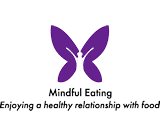How To Eat Better Through Mindful Eating
Many people rely on diets as a way to control their food intake and lose weight, but the trouble with diets is that you’re usually following someone else’s rules of what, and how much, to eat. Most diets expect you to follow its rules and ‘police’ yourself by eating ‘good’ foods and avoiding ‘bad’ foods. You’re also told how much of the food to eat- in this way, you don’t really think for yourself, or learn to tune into what foods are right for you and what amounts of them satisfy you. Eating according to rules and not according to your own ‘inner wisdom’ does not teach you how to eat better. People think that if they’re not on a diet they’ll be out of control of their eating, but this could be because they tend to be mindless eaters- if you eat mindlessly it’s easy to overeat. Becoming more mindful can help you to eat less, whilst getting as much, if not more, satisfaction from food. Mindful eating is about engaging the brain before you make a food choice, as well as whilst you’re eating. It can teach you how to eat better by helping you consider your food choices before you eat, to savour the food whilst you eat, and to know when you’ve had enough to eat. It doesn’t rely on using willpower to stay within a specific calorie limit, and it doesn’t involve eliminating any particular foods.
Regulate Your Eating By Letting Your Wisdom Guide You
 We have to make multiple food decisions every day, so learning to tune into what your body needs in any one moment can help you to make better food choices in terms of what and whether to eat. Getting into the habit of asking yourself good questions can help you to make more balanced, appropriate food choices and decisions. Step back to consider your options rather than simply diving in and eating whatever food is present- this can help you to make more satisfying food choices. Ask yourself questions such as: Am I hungry? Am I full? Do I want this just because it’s in front of me? Am I eating this just because of a mindless impulse to eat? How will I feel if I eat this? Am I experiencing actual hunger or ‘eye hunger?’ – our desire to eat can be heavily influenced by the sight or smell of food, not actual hunger. Relying on the power of choice that you have rather than relying on willpower to stop yourself from eating certain foods, is a valuable way to learn how to eat better- and can feel liberating.
We have to make multiple food decisions every day, so learning to tune into what your body needs in any one moment can help you to make better food choices in terms of what and whether to eat. Getting into the habit of asking yourself good questions can help you to make more balanced, appropriate food choices and decisions. Step back to consider your options rather than simply diving in and eating whatever food is present- this can help you to make more satisfying food choices. Ask yourself questions such as: Am I hungry? Am I full? Do I want this just because it’s in front of me? Am I eating this just because of a mindless impulse to eat? How will I feel if I eat this? Am I experiencing actual hunger or ‘eye hunger?’ – our desire to eat can be heavily influenced by the sight or smell of food, not actual hunger. Relying on the power of choice that you have rather than relying on willpower to stop yourself from eating certain foods, is a valuable way to learn how to eat better- and can feel liberating.
How To Eat Better By Being More Selective
One way of eating less food is to become more discerning, or selective, when it comes to food choices. It’s really important to enjoy food and to feel satisfied- not just in the sense of feeling pleasantly full, but also in terms of taste satisfaction. If you don’t enjoy a food you’re likely to go looking for more food soon afterwards, potentially leading to overeating. Ask yourself what you really want to eat- a good rule of thumb is to eat what appeals to you most and pass on the rest. Ask yourself questions such as: Which food is calling me right now? Will it actually taste as good as it looks? Do I really want to eat this? Am I considering any nutritional content of this food? Ultimately, you’re looking to find a balance between reducing your food intake and more enjoyment, and whilst it’s important to enjoy food, simply choosing foods because they taste good is unlikely to give the body the nutrients it needs to function adequately. As part of a quest to look after yourself, strive to balance pleasure with nourishment. Think of the ‘adding in’ mindset rather than a ‘taking away’ mindset- focus on adding more healthy foods into your diet rather than cutting out all the foods you love- just eat a bit less of those less nutritious foods.
No ‘Good’ Or ‘Bad’ Foods: Giving Yourself Permission
It’s important to give yourself permission to eat the foods you enjoy. If you think a food you love is ‘bad’ and you try to cut it out of your diet, it won’t be long before you feel deprived. The trouble with a ‘no’ mindset, that relies on harnessing willpower, is that you can’t continually struggle with strong desires for specific foods, and eventually you’ll give in. Try not to label foods as ‘good’ or ‘bad’. It’s important to enjoy food, rather than eating foods you think you ‘should’ eat, but don’t really enjoy. Give yourself permission to eat those foods from time to time, whilst eating them in moderate, controlled amounts.
Calorie Budget- Being Flexible
 Rather than thinking about which foods are off limits, think more about how much you can afford to consume. If you think of your eating budget as being similar to your financial budget, on some days you will spend (eat) more, on other days less. It can be liberating to realise that small amounts of your favourite foods can still fit into your budget- this is the basis of flexible eating- you accept that on some days you might eat more of certain foods than on other days, and you don’t beat yourself up about it. There will always be social situations where you can’t control what food is on offer, so deploy your ‘inner wisdom’ to enable you to still make some good food choices, and if you have a flexible mindset, you won’t regard the occasional overindulgence as a complete failure, enabling you to get back on track next day. There will always be situations where you eat less mindfully, but if you can anticipate such situations in advance you can accommodate those moments, not beat yourself up, and accept them as part of your journey in learning how to eat better.
Rather than thinking about which foods are off limits, think more about how much you can afford to consume. If you think of your eating budget as being similar to your financial budget, on some days you will spend (eat) more, on other days less. It can be liberating to realise that small amounts of your favourite foods can still fit into your budget- this is the basis of flexible eating- you accept that on some days you might eat more of certain foods than on other days, and you don’t beat yourself up about it. There will always be social situations where you can’t control what food is on offer, so deploy your ‘inner wisdom’ to enable you to still make some good food choices, and if you have a flexible mindset, you won’t regard the occasional overindulgence as a complete failure, enabling you to get back on track next day. There will always be situations where you eat less mindfully, but if you can anticipate such situations in advance you can accommodate those moments, not beat yourself up, and accept them as part of your journey in learning how to eat better.
Eating More Slowly And Savouring The Taste
To become a balanced eater, you’re looking to get to a point where you’re able to dispel the belief that food can only be truly satisfying if you feel stuffed, and to actually feel satisfied with less food. So how can we get more satisfaction from less food? The answer lies in eating the foods you particularly enjoy and savouring the taste. Eating slowly can help you to eat less- get in touch with how much food satisfies you, rather than mindlessly eating it all until it’s gone. If we can get in touch with understanding when our bodies are truly satisfied, both physically and psychologically, we can stop at the right point and not overeat.
Modest Indulgence: Eat Less Food But Feel More Satisfied
Small amounts of your favourite food don’t lead to weight gain. It’s possible to reduce serving size without reducing pleasure if you truly taste food and savour each mouthful. For example, you might find you can get more satisfaction from eating half a doughnut whilst savouring every bite rather than eating two doughnuts in a rush mindlessly and feeling guilty and remorseful afterwards. You can actually enjoy food more if you eat it mindfully, whereas with mindless eating there’s often less enjoyment. Your ultimate goal is to be pleasantly satisfied with what you’ve eaten, not uncomfortably stuffed and remorseful, so aim to let the quality of the eating experience preside over food quantity, rather than the other way round.
Get In Touch With Your Fullness Levels
Many people think that to feel satisfied, they need to be stuffed. You’re aiming more for being pleasantly satisfied, not stuffed. Try getting into the habit of rating your fullness levels on a scale of 1-10 to help you start getting in tune with different levels of fullness, and if you find you’re regularly eating to a 10, try to eat amounts that help you reach a 7 or an 8.
The main thing you need to remember is that adopting new eating habits doesn’t happen overnight- you need to be patient, kind to yourself and above all else, keep practising! To learn more about mindful eating, read my blog post ‘What is mindful eating?’.
If you feel you could benefit from my Mindful Eating service and would like an initial chat to find out more, give me a call (Emma Randall) on 07961 423120, or email me: info@mindfuleating.org.uk. I’m based in Lightwater, Surrey and offer online sessions via Zoom.
One-To-One sessions: buy three sessions up front and get a 4th FREE! To book an appointment, you can contact me via the contact form.
See ‘Services‘ for more information.

